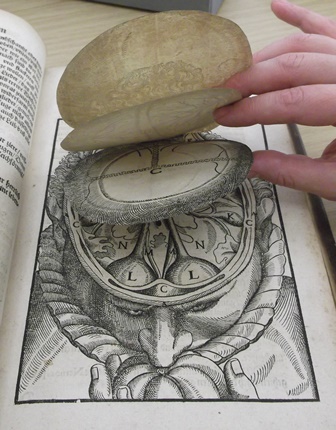Nora Wilkinson, Harvard University
Georg Bartisch was a surgeon and an inventor, but he is remembered primarily for his Ophthamoduleia (literally ”eye-service”), a treatise on diseases and disorders of the eye. The 1583 text is notable for several reasons. First, it is widely considered the first Renaissance treatise on eye disorders and surgery. Secondly, though most serious texts were written in Latin at the time, the Ophthalmodouleia was published in the vernacular, German. Finally, the book, which Bartisch published at his own expense, included ninety one full-page woodcuts, several of which were layered to act as flaps. As a result, the reader could examine different layers of the human brain (for example) by flipping through the woodcuts. This experience simulated the process of dissection for students, professionals, and the general public.
Bartisch was not the only one – nor the first – to include interactive flaps in his text. Heinrich Vogtherr the Elder introduced the layered flaps to anatomical prints in 1538 when he used 24 woodblocks to create an anatomical print of the female body. Vesalius’ Fabrica, which marks the beginning of modern anatomy, included flaps; and in 1619, Johann Remmelin included 120 flaps in the anatomical illustrations for the Catoptrum Microscopicum, which has been digitised by the University of Iowa. This technique was still used long after the seventeenth century: E.J. Stanley created layered illustrations for an anatomical textbook in 1901. Read more and watch anatomical flap books in action here.
As useful as they were for simulating dissection, paper flaps were used in more than just anatomical texts. Indeed, the 1570 English edition of Euclid’s Elements uses flaps to illustrate geometric concepts. And as explored in an earlier post by Sarah Wheale, harlequinades used flaps to create ‘a surprise unfolding of the story.’



